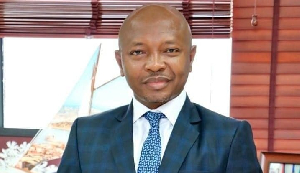On or about April 12th, 2017, I wrote a piece on the possible causes of loan defaults after one of Ghana’s 34 banks had published a notice to loan defaulters ‘encouraging’ them to settle debts owed to the bank.
The notice contained the names of directors of companies and individuals that owed the bank.
Banks will normally publish such notices if they have pursued all means to recover funds owed to them, and to make such a list then you really owe the bank a ‘truckload’ of money.
In recent weeks, a number of banks have published lists of loan defaulters in the dailies. And to my utter bewilderment, the same bank I chronicled in my piece last year was prominently featured.
I thought it prudent to share my piece again, although I have made some adjustments to reflect current developments in the financial markets and banking landscape.
I would not mention the name of the bank in this piece and will only refer to it as the “bank”.
A friend came across an interesting page in one of Ghana’s newspapers and pointed out to me a list of loan defaulters of one of the 33 banks in Ghana, now 34 as at April 2018. Not really fun to have your company name in the papers for loan delinquencies or defaults, is it? Interestingly, they had published both defaulting companies and the directors of said companies.
The bank would have tried tirelessly in getting what they are owed and as a result, will resort to publishing the defaulters’ names. From the customer’s perspective it’s below the belt, but from the lender’s it’s a necessary evil.
But let’s forget the defaulters for now and concentrate a bit on the rates of the “bank” in question. As at April 2018, the bank is one of the 34 commercial banks in Ghana according to data from the Bank of Ghana.
When you examine the Bank of Ghana’s data on Annual Percentage Rates and Average Interest Rates on Deposits in February 2017 (at the time I wrote the piece) you’ll notice something interesting.
Per the report and banks captured, the “bank” had the highest industry average for interest on deposits at 17%, a good bargain for bank customers but relatively high for the industry. Examining Bank of Ghana’s same report in February 2018 that same bank had an average rate on deposits at 11%, a 6 percentage point drop.
Again, from the same report, the “bank” it had the second highest base rate in the industry at 35.5%. The base rate is the minimum rate at which a bank can lend or give out a loan. Already the base here is 35.5% so you can imagine what rate you would borrow it! In the February 2018 report, the base rate dropped to 29.4%. What constitutes base rates in banking?
1. Cost of funds: how much interest you are paying on deposit accounts, be it demand deposits, fixed deposits, savings deposits, borrowings etc.
2. Loan loss provision: that is how much a bank will set aside to cover its bad loans.
3. Profit margin/shareholders return: a corporation exists to maximize shareholder value. Primarily, how much are you giving back to your equity contributors.
4. Operating expenses: how much it’s costing you to run the business of banking.
The variables here are generic as they are generally used in banking literature. However, the bank hasn’t factored in the individual’s or the industry’s peculiar risk to the loan pricing.
Others may factor in variables after the base rate calculation for the overall loan pricing which results in a differential interest rates in the banking industry.
The regulator of the banking industry, The Bank of Ghana, realized the challenges this had posed to the industry and in “consultation with the Ghana Association of Bankers reconstituted a Working Group to review the existing Base Rate model and develop a new framework for base rate determination.
The objective of the review among others is to fulfil its commitment to move towards a more market-based model of base rate setting, in the medium to long-term.
The ‘Base Rate’ emanating from this model is now a Reference Rate rather than a Minimum Lending Rate for all banks as was the case with the previous model.
A bank shall price its Flexible and Fixed term loans by adding or subtracting its risk premium to the Ghana Reference Rate. Flexible or floating term loan for any tenure granted by a bank from the implementation period will reset after each month’s publication of the GRR. Fixed term loan rates granted by a bank in its normal course of business from the implementation date will, however, run until maturity.”
From the February 2017 report, both household and enterprises loan classifications have average rates of 35.5%-40.5%. Also in finance, there’s what is called effective annual rates (simply, it’s what you will really pay for a loan after a bunch of critical yet boring calculations are conducted). So it may be just north of what you are actually paying on paper.
What is the role of a bank? Banks are supposed to accept sustainable deposits and on-lend to spur growth, but the rates on deposits go a long way (including other factors) to influence the rates on lending.
Banks make money from their interest rate spreads (a difference between the lending and the deposit rates). Invariably, the higher rates on deposits, the higher the lending rates. The higher the rate spread, the more profitable the bank is all things being equal.
So granted, looking at the “bank's” dynamics i.e. rates on deposits and rates on lending one can argue it is justified. They are in business to make profits (Milton Friedman, 1962, 1970) “the business of business is to increase its profits.” They are supposed to return maximized value to shareholders. But in a broader sense, they are supposed to factor in others: society, government, employees, etc. But that’s a debate for another day!
So let’s examine the possible causes of the high rates of the bank in question and the reasons for default; the bank in question is relatively a new bank in the country and thus attracting deposits in an already squeezed market looking at individuals who are banked and unbanked will come at a cost. To attract deposits and grow customer base, they might offer relatively higher rates on deposits such as their average of 17% on deposits as of February 2017.
Cost of funds will shoot up and will feed into both rates on deposits and base rates, which is inextricably linked to lending rates.
In addition, other factors include operating expenses where they would have to purchase new operational equipment to ensure they can match up to the competition. This will greatly affect the base rate and affect the lending rates.
The loan defaulters may also have certain systematic risks (risks which are part and parcel of the category of defaulters) and thus if a relatively high proportion of their loan portfolio is exposed to such already risky borrowers then pricing the loan higher will be apt to forestall any losses.
This high pricing will have to be in tandem with their capacity to absorb the debt, capacity to repay from cash flows generated by the business. Let’s assume broader macroeconomic challenges affected their cash flows and thus their repayments. It will eventually lead to a level of default, if not managed properly.
What is the way forward in regards to loan defaulting?
A whole host of factors go into loan default issues from both sides. They emanate from borrowers and lenders as well as the regulatory and economic front. But they largely boil down to information asymmetry. (Relationship where two or more parties to a transaction would possess different amounts of information. Such that one party “bank” may possess more information than the other party (borrower) and vice versa. This will result in the banking lending to wrong people (adverse selection).
They might lend to a borrower who may not necessarily have the capacity to take on the debt and repay and in some cases channel the funds to unfruitful ventures which are termed moral hazard.
The following may be considered to reduce the problems of loan defaulting;
1. KYC, KNOW YOUR CUSTOMER, should be stringent before accounts are opened and loans disbursed. Poor assessment by lenders of the risk inherent posed by the borrowers etc. This KYC can be expanded to include what I would call an effective screening.
Apart from this the monitoring of borrowers should be dome regularly and should not be left until a loan starts to show signs of default before taking action.
Finally, if there is a loan that has already gone bad, then enforcement should step in to ensure these loans are fully repaid. Use of the courts and the publishing of defaulters are some of the means of enforcing these repayments.
2. From the regulatory/economic view, a proper identification system, address system etc. will go a long way to resolve some of the issues. Economic stability (stable inflation rates, stable currency) should also prevail.
Strides have been made in some areas and especially to interest rates, lowering them and making them friendlier to the ordinary borrower.
Some may argue lending rates have dropped only marginally. The Bank of Ghana’s Summary of Economic and Financial Data for May 2018 revealed the average lending rate in Ghana as of April 2018 is 28.2% down from 30.5% in April 2017. Clearly, it’s marginal. More will have to be done in order to make our bank lending rates more borrower-friendly.
The points I have discussed are by no means exhaustive as there are several angles to the issue of loan defaulting.
As individuals, let us examine our finances before we decided to borrow and seek proper advice from certified financial analysts or the banks. It’s a burden on your shoulders to take a loan and have a bank ‘chasing’ you for repayment.
In our part of the world, such instances are described as a sheer display of negligence and deceit on the part of a borrower but this may sometimes not be the case. Be sure of what you want to do before you borrow and make sure you have a clear, clean and sustainable source of repayment.
The banks should also not be in a hurry to lend because they want to grow their loan books but should be vigilant in who they lend to.
DISCLAIMER: It’s important to note that no specific bank is on the spot here. Data used here is from the industry regulator, the Bank of Ghana and it is public information. The reasons for defaults and solutions are my opinions, not facts and do not reflect in any way, shape or form that of any other financial institution, body or entity.
Opinions of Monday, 25 June 2018
Columnist: Philip Nanfuri
Tackling loan defaulters in Ghana’s banking sector
Entertainment














